A 4-Step Digital Marketing Strategy Framework
This article aims to equip you with a fundamental understanding of what digital marketing is, how successful companies are doing it, and what processes are required in place to ensure a successful digital strategy for your business.
We hope after reading this, you’ll better understand:
- The modern consumer journey and the role of digital marketing.
- How to apply a 4-step digital marketing framework to your business.
This digital marketing strategy resource is broken down into two parts:
- The Shift From Traditional Towards Digital
- How to Implement a 4-Step Digital Marketing Framework
Part 1: The Shift From Traditional Towards Digital – How the Consumer Buying Journey Has Changed Over Time
Traditional advertising methods still work today, but are no longer as effective and cost-efficient today as they were.
- TV has been overwhelmed by online video streaming sites such as Youtube.
- Flyers have been replaced by online banner ads e.g. Google Display Network (Ad exchanges).
- Radio has been suppressed by podcasting sites such as Spotify.
- Flyers and direct mail is mostly ignored today and is much more expensive compared to email marketing.
- The sale of newspapers have sharply declined as more and more readers turn to online news sites.
- Offline advertising methods are harder to track (in terms of viewership & browsing behaviour) than online marketing channels.
As John Wanamaker, the founder of advertising said, “Half the money I spend on advertising is wasted; the trouble is I don’t know which half.”
What is the traditional marketing funnel?
In the traditional marketing funnel, a consumer is made aware of a brand’s existence, compares and considers a brand’s competitor products, and makes a decision to purchase a chosen product. The consumer then enters the customer loyalty phase.
If you’ve ever sat in front of a sales presentation and signed up for a product or service after being convinced, you may have experienced the whole funnel in one sitting.
This linear process is inflexible as the consumer buying process today is no longer linear. Today, consumers enter the buying process at different stages, jump stages, and move back and forth between them.
Here’s the scenario of a typical consultation with an insurance agent selling you a policy.
Awareness
The insurance agent starts by asking you whether you’re aware that you should have an insurance plan to protect your finances in the case of an unfortunate incident.
Interest
Should you develop interest, she’ll go on to explain different insurance policies (life insurance, investments, etc) that are available.
Desire
You may then inquire whether the insurance policy you intend to get is the best deal out there, and your insurance agent will highlight the key advantages of their policies compared to other insurance companies.
Decision
Once you’re convinced, she’ll hand you a form to fill in your application.
Today’s consumer decision-making process
Consumers today have the means to do their own product research at home online and on-the-go on their mobile phones. The control is shifting from marketers to consumers, as consumers now have to power to block ads, conduct their own research, and opt out loyalty marketing programs.
For example, a movie fanatic, Anne, may be shopping for clothes when she suddenly decides to watch a horror movie. In modern marketing, this is known as a “buying trigger” or a “micro-moment”, as Google calls it.
Anne would then search for “new horror movies” on Google and watch movie trailers, read user reviews on IMDB, and ask friends on Facebook for their opinions, in any random order, before ultimately deciding on a movie. She would now go online to compare cinema ticket prices and eventually purchase her movie tickets from Cathay Cineplexes.
Cathay Cineplexes now has Anne’s contact details and slots Anne into their loyalty program which regularly emails her membership discounts, movie bundles, etc.
Case Study – A Consumer’s Laptop Buying Journey
Here’s an interview of a consumer’s laptop buying journey:
“It all started out with a Trigger moment (Micro moment) when I needed to buy 20 laptops for our newly launched IT training course.
I then asked some friends if they knew of any cheap deals, and went to Challenger and Best Denki to source for them, but could not find anything within my budget.
Later at home, I went on Google to search for cheap and good laptops and landed on Lazada and Qoo10. I also sourced the internet for articles on the pros and cons and hardware specifications on various laptop brands.
Eventually, I narrowed down to a $650 Lenovo laptop after discount. I considered all the options and remained stagnant in the consideration phase for a few days.
While I was having lunch at a Vietnamese restaurant and surfing Facebook, I saw a sponsored ad from Qoo10 on Facebook on how refurbished laptops are better for your wallet and can perform as well as new laptops. I read the article and was convinced I should buy 20 refurbished laptops. At the bottom of the page, there were related product links to refurbished laptops. How convenient! It was then I became a proud owner of 20 refurbished Dell laptops.”
#Tip of the day
What can a marketer do, knowing how valuable this information can be?
- Interview consumers who own both refurbished and brand new laptops to find out the reasons why consumers chose their current buys and what were their buying journey experiences like by:
- Setting up focus group studies
- Interviewing existing customers through online and offline channels
- Conducting market surveys
The Consumer Buying Journey today is no longer linear. Marketers have to ensure consumer-brand interactions on as many relevant touch points as possible on the path to purchase.
Key takeaways:
- Modern marketing is no longer “push” marketing (as traditional marketing is), as consumers today have access to a boatload of information within a click of a button.
- Effective modern marketing is being engaging and useful (via Content Marketing, Email, Search, Social, Display, Mobile) at relevant touch points during the consumer’s journey.
- Understanding the customer buying behaviour (e.g. which social media networks they hangout on, which websites they visit to check for product reviews, what keywords they search for on Google) through Digital Analytics is essential in order to calibrate all online marketing efforts to each specific customer profile and effective channels.
- The trend is shifting toward a two-way communication – consumers are able to voice out their frustrations on social media, as compared to a one-way communication in the past – customers were being marketed to via radio, television, and banner ads. Marketers and PR executives need a more systematic way of managing negative reviews and customer support. No longer are brands in total control in the marketing funnel today.
- Conduct research (e.g. customer surveys, feedback, interviews, focus group studies, etc.) to identify and understand buying triggers or micro-moments in order to build trigger-specific message and content around relevant touch points in the customer journey.
Part 2: How to Implement a 4-Step Digital Marketing Framework
Digital Marketing is basically…
Marketing via digital and online tools and channels, as opposed to traditional marketing (TV, Billboards, Flyers, Newspapers, and basically any form of print advertising).
Digital Marketing is NOT…
A one-size fits all marketing solution. It is important to look at your business goals and not limit your activities to only one marketing channel.
Digital marketing can complement your traditional marketing efforts and vice versa. For example, ABC Flower Store can hand out coupons to their shoppers upon checkout at the cashier. These coupons can then be used on ABCs e-store where customers can create a membership account and receive a discount on bouquets ordered online.
Furthermore, ABC Flower Store can track (via digital analytics) how many customers actually used these coupons, and can use the data collected (email address, mobile no., mailing address) to build a loyalty program via email, mobile, mail postage.
There are many schools of thought on how many digital marketing channels and disciplines actually exist.
Here, we’ve consolidated them into nine individual channels and disciplines:
- Search Engine Marketing & Search Engine Optimisation
- Display Advertising
- Social Media Marketing & Online PR
- Email Marketing & Marketing Automation
- Content Marketing
- Mobile Marketing
- Web Design & User Experience (UX) Design
- Digital & Web Analytics
- Conversion Rate Optimisation
These 9 digital marketing channels and disciplines can be implemented to one or more digital marketing campaigns.
A 4-Step Digital Marketing Framework
Phase 1: Define
To apply this framework to your business, start off by defining your audience, business goals and buying triggers. This is crucial to ensure you kick off on good ground.
Phase 2: Implement
Based on what you’ve defined in the first phase, you then implement the most appropriate digital marketing strategies through various channels to create awareness, engage, procure, and retain customers.
Phase 3: Analyse
Once you’ve ran your campaigns, you need to collect and analyse data (e.g. which channels generate more ROI, which audiences are more likely to purchase) in order to further optimise and boost your ROI.
Phase 4: Optimise
This is the crucial phase, where you make minor to major changes (e.g. from lowering your ad spend on a digital marketing channel to targeting different audience segments) based on your digital analytics data.
An Alternative View of This Framework:
Applying the 4-Step Digital Marketing Framework on a Mockup Company
For illustration purposes and to put the following information into context, we’ll be simulating developing a digital marketing strategy for a travel company.
Let’s name this company…
Phase 1: Define
In the first phase (Define), you’re basically looking out for these 3 things:
- Who’s going to buy from you? (Audience Definitions)
- What will make them buy from you and when? (Micro-moments/Buying triggers)
- What do you want them to do in order to buy from you? (Macro & Micro Conversions/KPIs/Goals)
Audience Definitions
Defining your audiences at the beginning of your digital marketing campaign enables you to reach out to them via the correct digital channels and also create effective marketing collateral (video and written content (ebooks and helpful guides), ad creatives, electronic direct mails (EDMs), e-brochures, etc.) that they can resonate with.
Note: Audience definitions may vary from industry to industry.
Defining Micro-Moments/Buying Triggers
A micro-moment or buying trigger is when a consumer discovers a problem and acts on it.
For example, Home Depot got powerful results when it used location extensions for display ads to reach home and garden enthusiasts on mobile. The brand reached consumers in their intent-rich moments—when they were looking for outdoor garden products—and brought them into nearby stores.
Your job as a marketer is to identify these micro-moments and be present when they happen.
Defining Macro & Micro Conversions (KPIs)
It is important to define both macro and micro conversions early on in your digital marketing campaigns, in order to target the right audiences and marketing channels. You can view them as KPIs of your marketing activities.
Macro conversions are the big picture goals of a business. For example, growing the membership base of a paid subscription Software As A Services (SAAS) company.
Micro conversions are the milestones that eventually lead to the macro conversion. For example, a 30-day trial signup which may lead to a paid membership upgrade is an example of a micro conversion.
Phase 2: Implement
Based on the variables, scenarios, and conditions you have defined, you can then deploy a digital marketing campaign and target the most appropriate digital marketing channels to engage with your target audience on as many relevant touch points as possible.
Implement SEO & SEM
Based on the Micro-moments and Buying Triggers definitions, we can launch Travellers Beyond ads on Google Paid Search using Google AdWords and optimise the travellersbeyond.com website to rank on page 1 on Google’s organic search results by implementing Search Engine Optimisation (SEO).
To learn how to rank your website on page 1 of Google both organically and on paid search, sign up for our SEO course and Google AdWords course.
Implement Display Advertising with Facebook Ads
Using Facebook Sponsored Newsfeed ads, we can target visitors who have visited travellersbeyond.com, but did not book a travel package with us.
For help and step-by-step guides on how to launch a Facebook Ad, sign up for our Facebook Marketing and Advertising Course.
Implement Content Marketing via Guest Blogging
We can guest blog on travel sites with an audience of frequent travellers to build brand and product awareness.
Tip: If you include any links in your article back to travellersbeyond.com, be sure to tag them with UTM parameters to report referral traffic in your analytics platform. For Google Analytics, you can use the Campaign URL Builder.
Implement Social Media Marketing
You can launch a contest for your social media fans to take part in. This will not only encourage sharing and brand awareness, it will also increase brand loyalty and brand engagement.
For this, you will require a Facebook Page:
Here are the steps to create a Facebook Page:
1. Go to facebook.com/pages/create.
2. Click to choose a Page category.
3. Select a more specific category from the dropdown menu and fill out the required information.
4. Click Get Started and follow the on-screen instructions.
Discover the 6-step social media marketing process to creating, managing, sustaining and measuring your Social Media Marketing efforts in our 2-day Social Media Marketing training.
Implement User Experience Web Design and Conversion Rate Optimisation
Your landing pages are one of the important touch points of the consumer journey. If you fail to convert your visitors here, your would see very little ROI on all your marketing channels.
Be sure to optimise for conversions when building your landing pages. We can implement Conversion Rate Optimisation by conducting an A/B split testing experiment.
For example, we can test the CTA button with A – “Book Now” against B – “Go On An Adventure Today” to determine which CTA led to more form submissions.
You may use Google Content Experiments as a free solution for A/B testing.
Learn how to create, customise, and maintain a website from scratch in our 2-day hands-on WordPress Website Creation course.
Phase 3: Analyse
What to Analyse?
There are a ton of metrics you can measure and analyse – From audience demographics, acquisition channels, average time spent on landing pages, bounce rates, top conversion paths, to dozens of goals and smart goals in each digital marketing campaign. What you need to analyse depends on the objectives you’ve set and the type of digital marketing campaign you’re running. Below are some two key things to track and analyse for an overall digital marketing strategy.
Analyse Audiences
Segmenting and analysing your audiences can give you insights on their browsing and buying behaviour, and can allow you to focus on targeting higher ROI audiences and improve your user interface (UI) and user experience (UX).
In your Google Analytics reports, navigate to Audiences => Overview and you can segment your audiences by demographics, interests, geolocation, device types, and more.
To enable this report:
1. Sign in to your Analytics account.
2. Click Admin.
3. Navigate to the account and property where you want to use Demographic and Interests data.
4. In the PROPERTY column, click Property Settings.
5. Under Advertising Features, set Enable Demographics and Interests Reports to ON.
6. Click Save.
We can compare which country had the highest number of goal completions i.e. macro and micro conversions that we have defined in Phase 1.
To access this report in Google Analytics:
1. Navigate to Audiences
2. Click on Overview
3. Under demographics, select Country
4. Click View Full Report
In the above table, we can see that Singaporeans alone accounted for 12,107 goal completions (conversions).
We can also break down users by device category.
To access this report in Google Analytics:
1. Navigate to Audiences
2. Click on Overview
3. Under demographics, select Country
4. Click View Full Report
5. Under Secondary Dimension, select Users => Device Category
Singaporeans using Desktops accounted for majority of the conversions.
We can also analyse which age group had the highest number of goal completions i.e. macro and micro conversions that we have defined in Phase 1.
To access this report in Google Analytics:
1. Navigate to Audiences
2. Click on Overview
3. Under demographics, select Age
Learn how to analyse advanced Google Analytics reports and produce actionable insights in our Digital & Web Analytics (Google Analytics) course.
Multi-Channel Attribution
What is Multi-Channel Attribution?
Put simply, multi-channel attribution is giving relative credit to the channels which played a part in securing a conversion. Multi-channel attribution allows you to credit all digital marketing channels involved in driving conversions. The credit value (attribution amount e.g. 0.1 – 1.0) is dependent on the significance of the channel in influencing the conversions. See multi-channel attribution models explained here.
For example, in a soccer match, we have the goal keeper, defenders, mid fielders, and strikers.
When the team scores a goal, we can attribute equal credit to each player. We can also attribute different credit values to each player, depending on the importance of their roles.
For example, if the goal keeper kicked off the ball and the team scored, he would get 100% credit if we used a first-touch attribution based model. If we used the linear attribution model, each soccer player who touched the ball would get equal credit.
Attribution Modelling Example Scenario
A potential traveler, interested to travel to the caribbean islands, Googles “caribbean island travel deals” and lands on your website www.travellersbeyond.com.
One week later, she returns to your website by clicking on a Facebook Sponsored Newsfeed ad.
The following day, she clicks on an email link to an article on your website.
On the same day, a 3 hours later, she returns to your website directly by typing in your URL into her browser’s address bar and makes a booking.
Position Based Attribution Model
Using the position based attribution model, we can see that organic search channel was the biggest player in terms of influencing conversions.
To access this report in Google Analytics:
1. Navigate to Conversions tab
2. Under Attribution, select Model Comparison Tool.
3. Choose from default models e.g. Last Interaction, First Interaction, Position Based, etc.
Phase 4: Optimise
What to Optimise?
There are a ton of things to optimise in your entire digital marketing campaign.
Let’s leave testing and optimising button clicks, ad creatives, and landing pages to the respective digital marketing disciplines i.e. UX Web Design and Conversion Rate Optimisation.
Let’s focus on these two metrics and optimise your campaigns from a top-level digital marketing point of view:
Audience Targeting
Based on our analysis (Phase 3), we can observe that Singaporeans, age 25 – 34 years old, who mainly use desktops, are our largest target audience. They made up for 42.14% of all conversions from all age groups.
With this knowledge on hand, we can craft our marketing collateral (both online and offline) in a particular tone and style that’s targeted to this demographic. If we have data where they often hang out, e.g. which websites, social media platforms, online/offline channels, we can also launch marketing campaigns (both online and offline) to target them on these channels.
Once we have targeted one audience group, we can move on to test different audience groups by launching the same or different digital marketing campaigns to another audience group. After collecting and analysing the data, we can adjust our campaigns to the best performing audience groups.
Marketing Spend on Digital Marketing Channels
Based on multi-channel attribution model data, we can assign/reassign our marketing dollars to the best performing channels.
If our focus is on branding and awareness, we would most likely use the first-touch attribution model (100% credit to the first marketing channel interaction), and pump more dollars into the channel which drove the most conversions.
On the other hand, if we used the position-based attribution model (40% to both first and last touch, 20% split evenly to everything in between), we would assign more marketing dollars to the first and last marketing channel interaction.
Putting It All Together
We can put all the information gathered from your entire digital marketing campaign and present this 4-step digital marketing framework into the following table:
Modern marketing concepts are not much different than traditional marketing, in that they both focus on the buyer’s journey. One of the key differences between modern vs traditional is in the marketing/advertising mediums which have gone digital (e.g. Search Engines Vs Yellow Pages, Digital Advertising Vs Print Advertising).
The other key difference is that the consumer buying journey is no longer linear. Your job as a modern marketer is to define the relevant touch points in the consumer journey, engage them at as many of the touch points as possible (e.g. Search, Social, Email, Blogs, etc.), track and analyse audience behaviour (e.g. conversions), and optimise your audience targeting and marketing budget for the most effective digital channels.
We hope this article has given you a better understanding on how digital marketing works and how to apply a 4-step process (Define => Implement => Analyse => Optimise) to your existing business.
This is just the tip of the iceberg, however. We offer a range of digital marketing courses taught in-person in Singapore or online to equip you with actionable digital marketing strategies across multiple digital channels and platforms. You may also want to check out digital marketing events hosted by Equinet Academy, here in Singapore.
Dylan Sun is the Founder of Equinet Academy, a SkillsFuture Singapore WSQ-Accredited Digital Marketing training organisation. Passionate in all aspects of Digital Marketing and SEO, he extends his passion to helping people implement effective digital strategies to their businesses. Follow his blog at Equinet Academy to learn more about Digital Marketing.

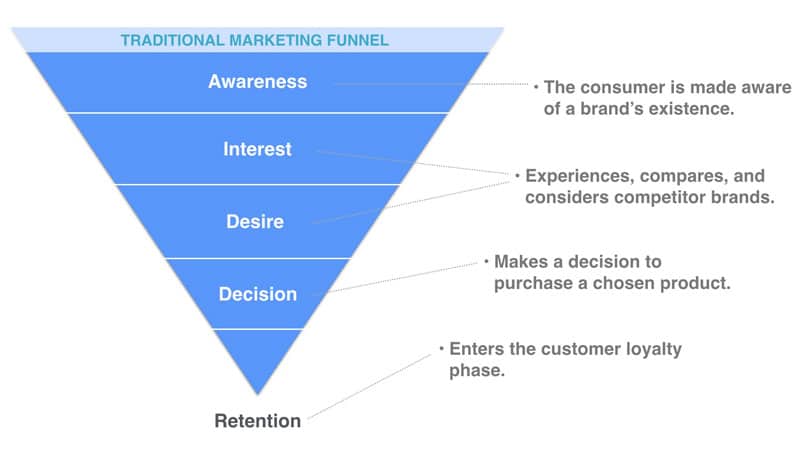
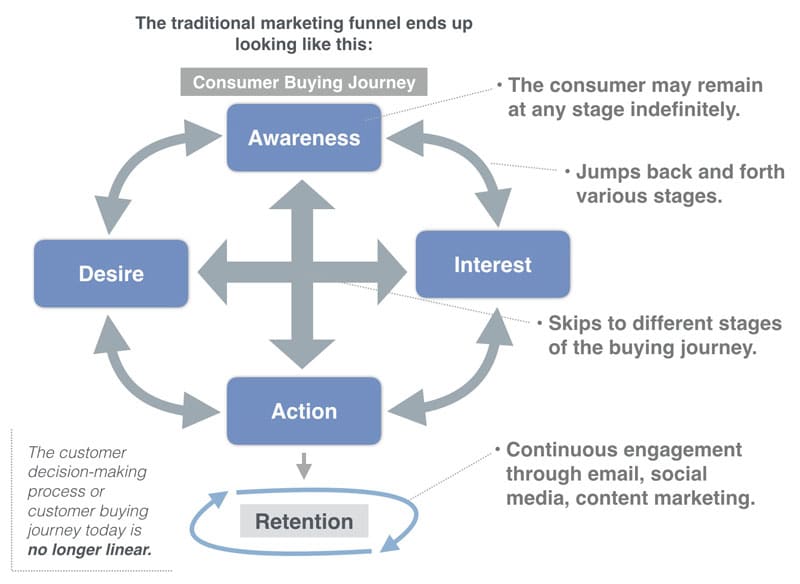
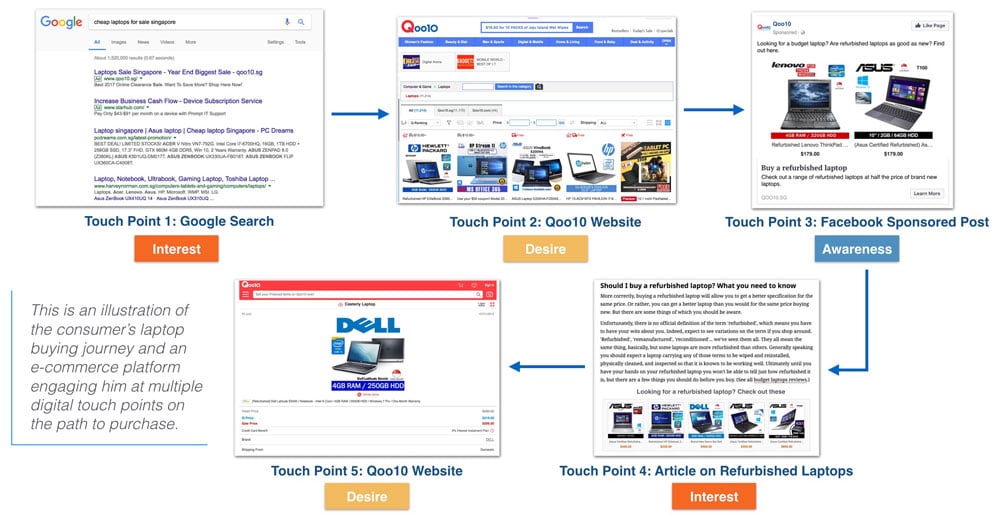

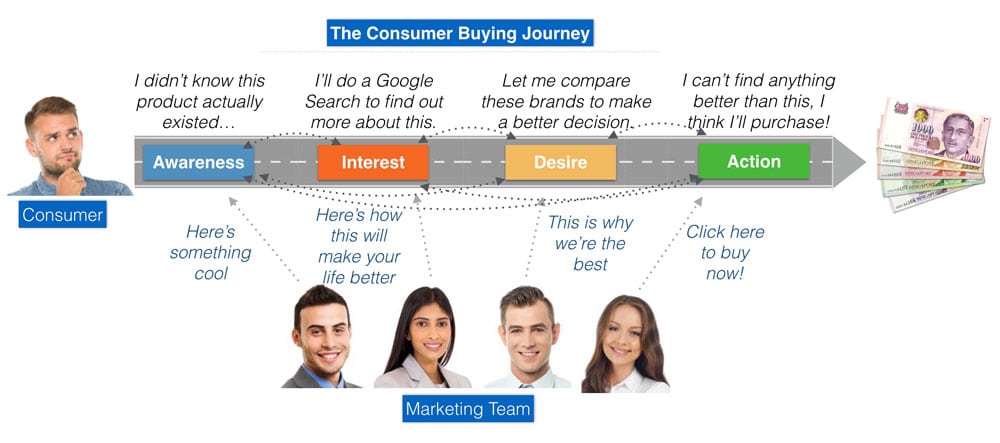
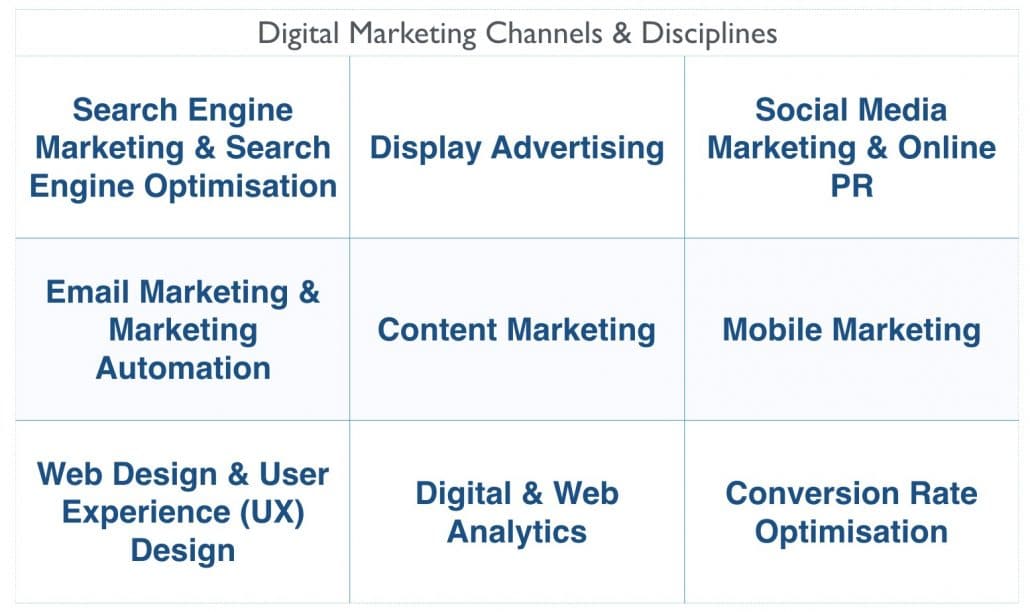
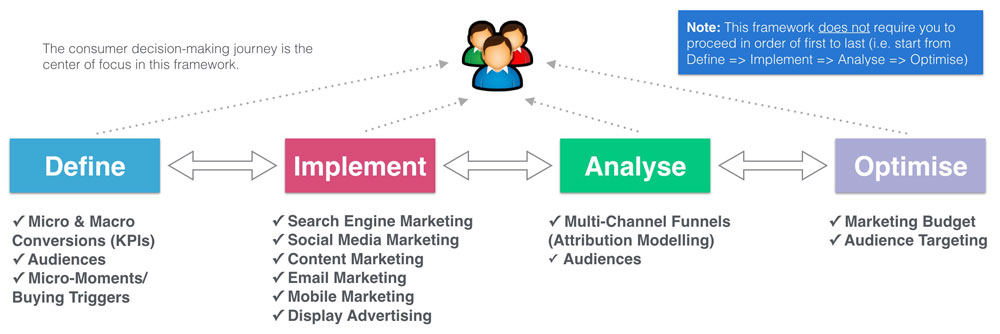
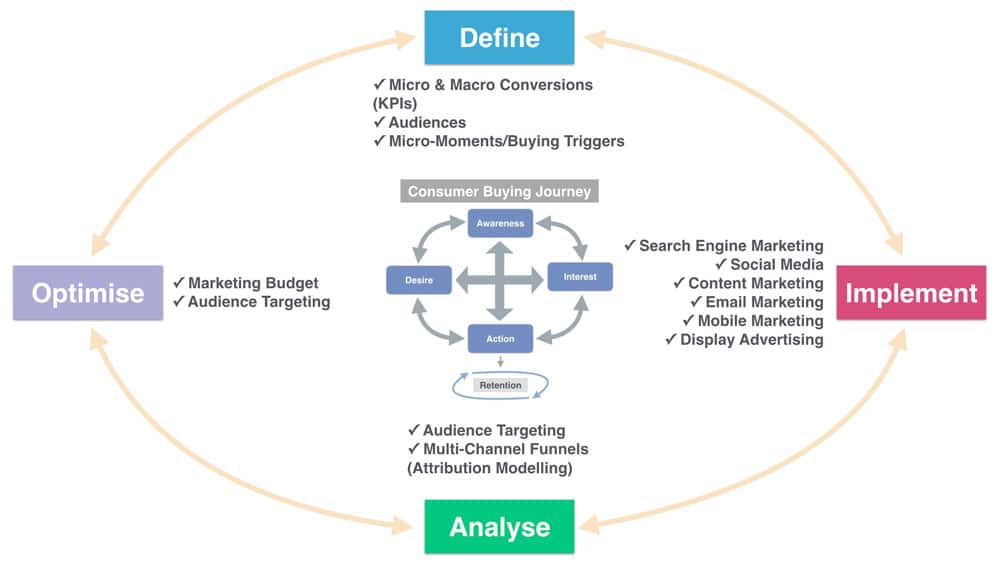

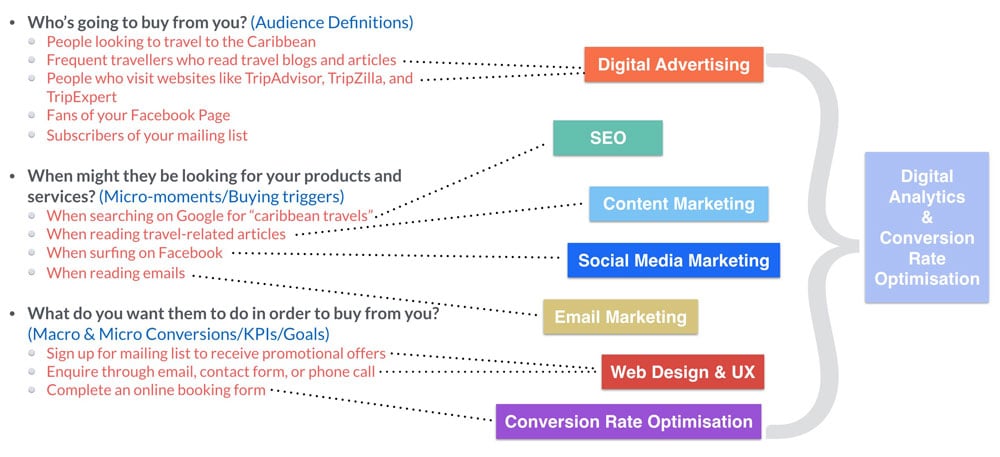
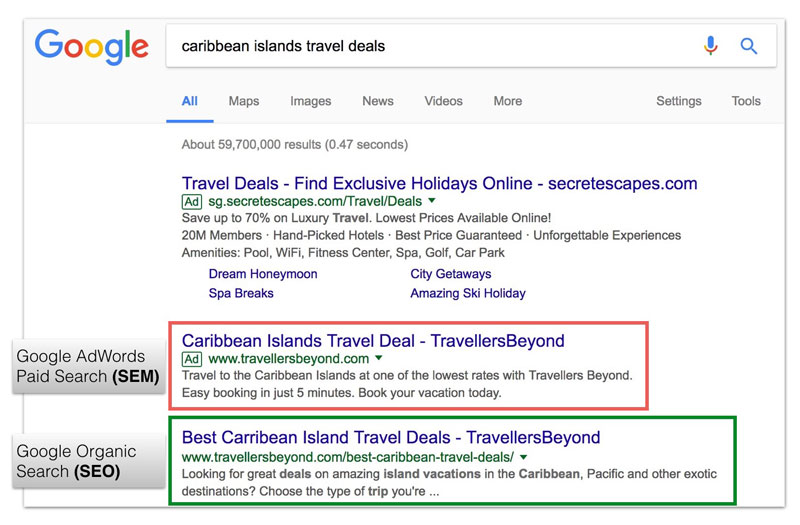

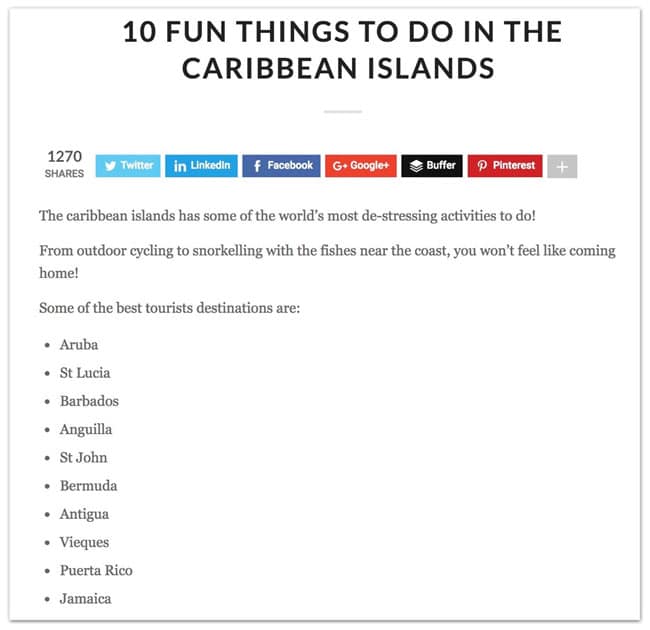
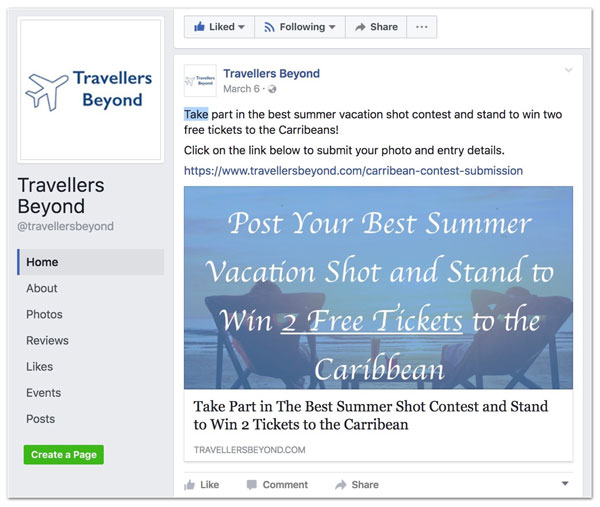
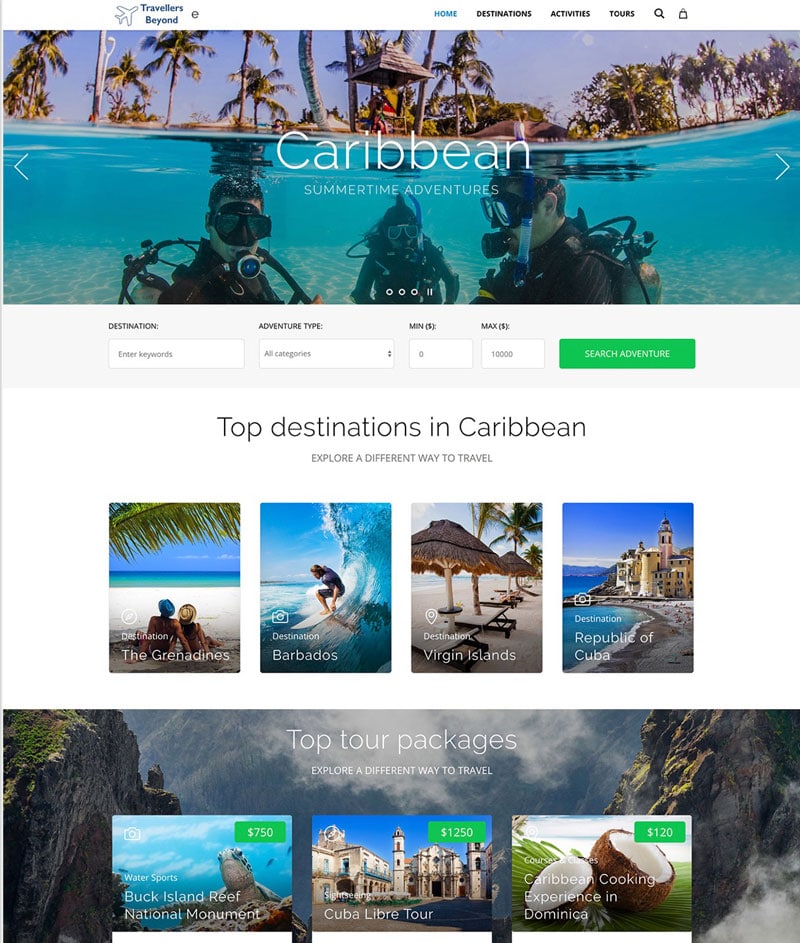
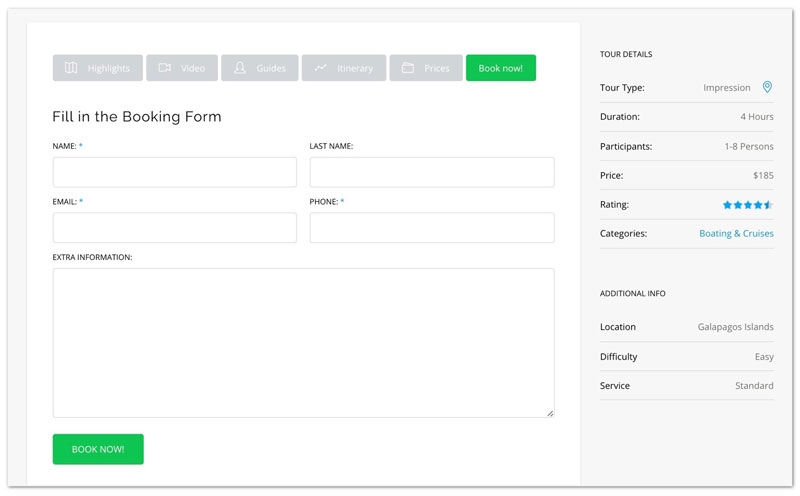
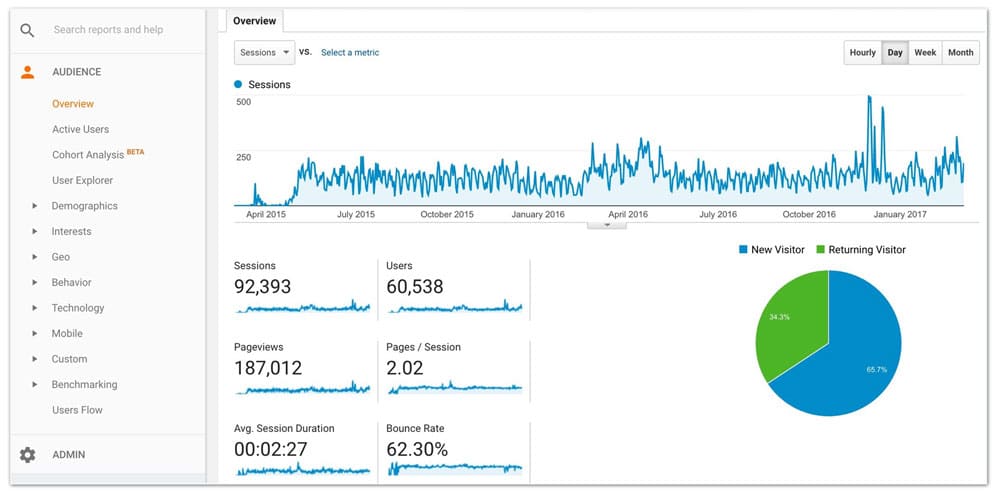
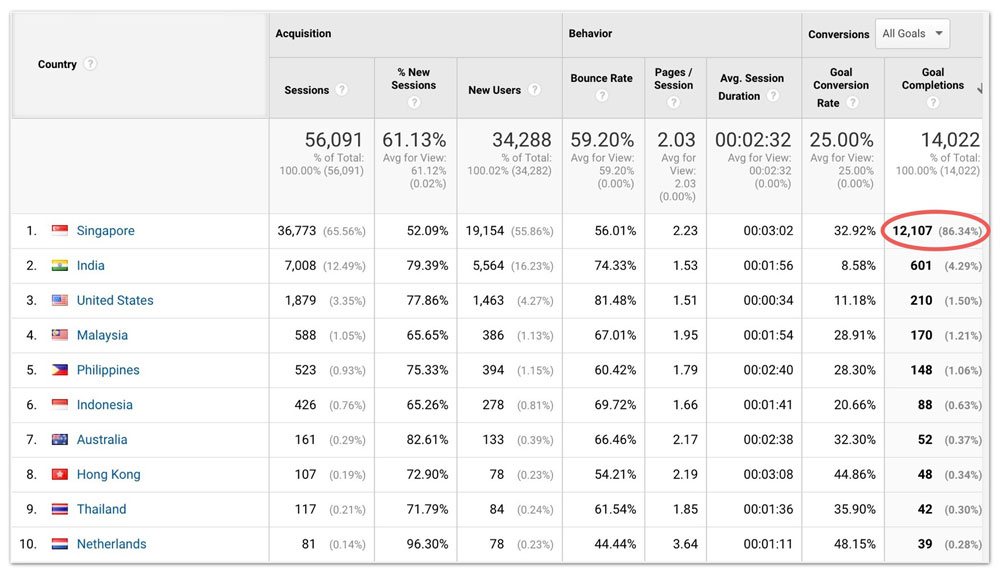
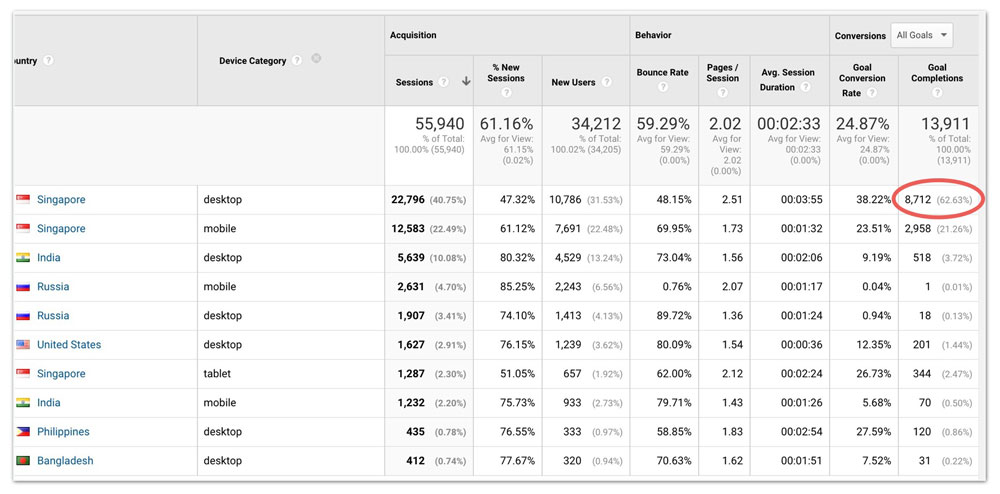
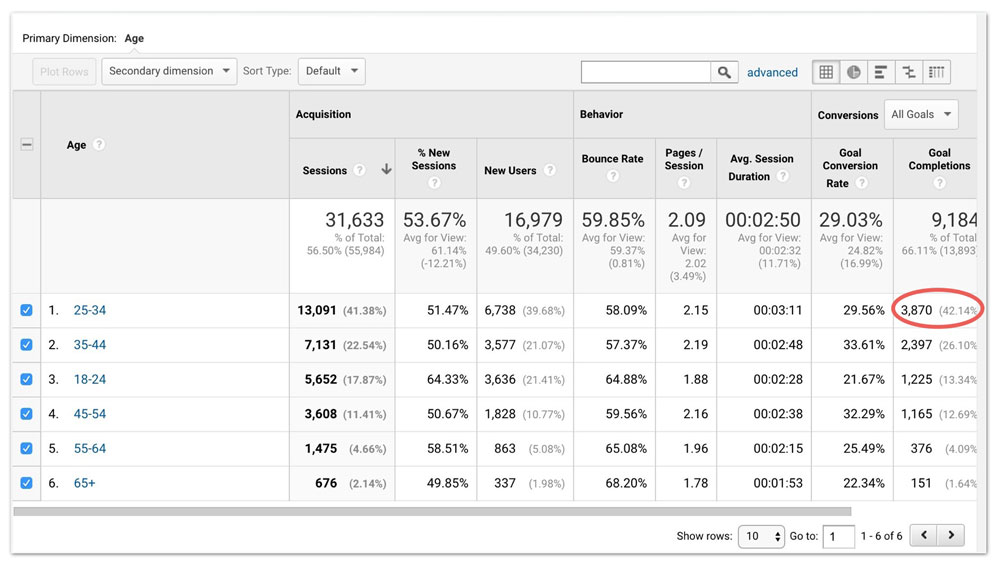
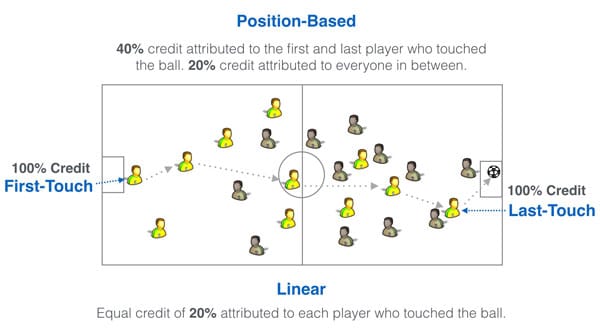
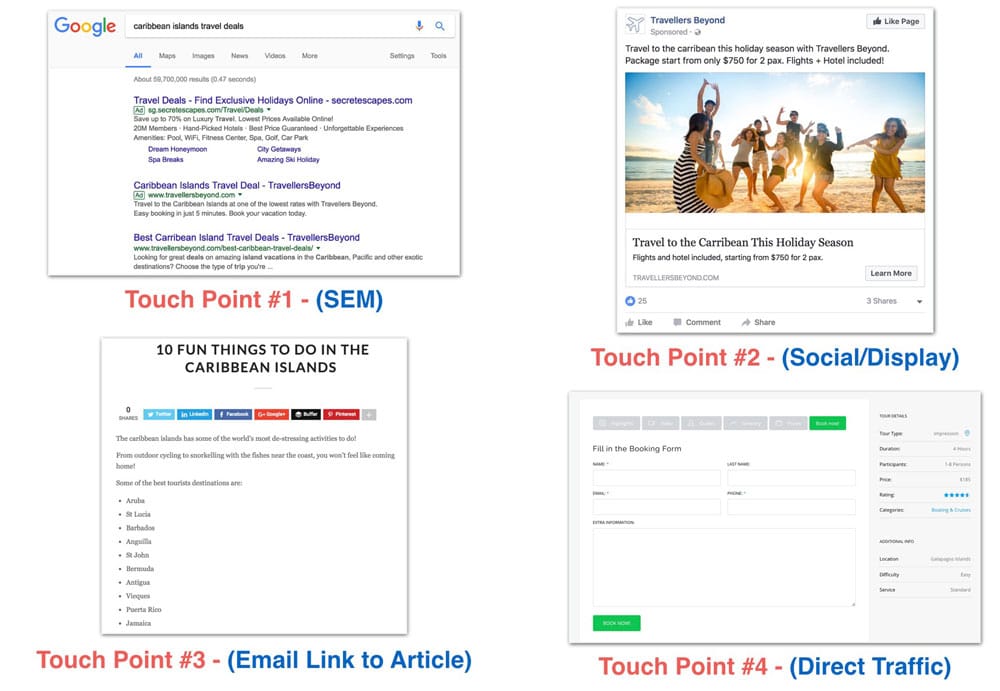
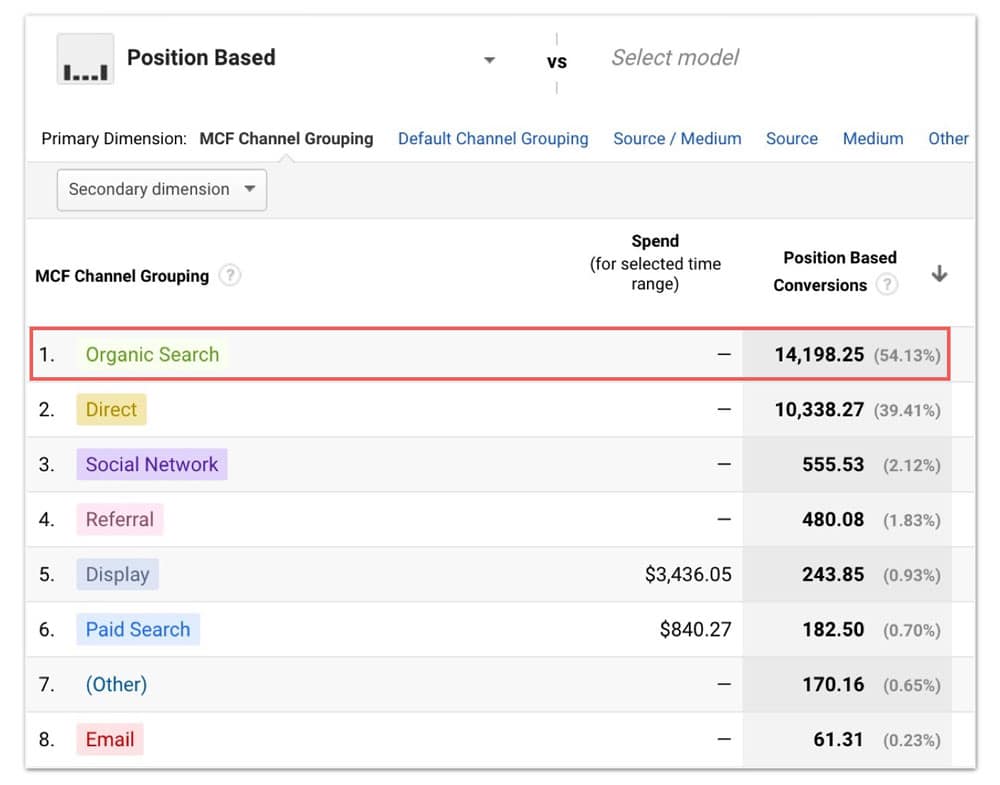
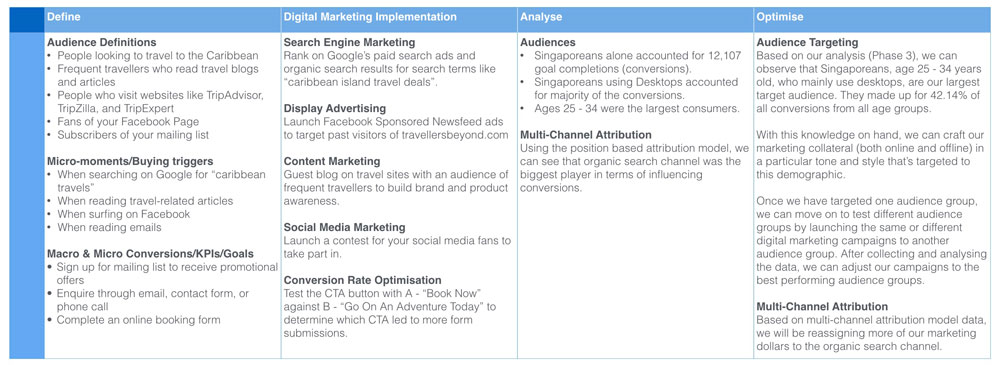

Excellent guidance to start proper and right digital marketing strategies. This is such a great post. Loved it. Thanks for sharing!
Thank you for your kind words!
Superb article. U now have a better understanding on Digital marketing. Thanks Dylan!!!
Thanks for stopping by Kavi. Glad it helped you gain a better understanding on Digital Marketing!
A well-detailed post on how to step a digital marketing campaign. Thanks for writing and sharing this.
Great article! Thanks for sharing the complete guide about digital marketing and its types. Keep sharing valuable information.